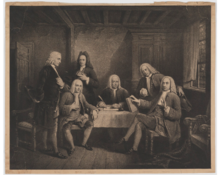| First Secession | |
|---|---|
 | |
| Classification | Protestant |
| Polity | Presbyterian |
| Origin | 1733 |
| Separated from | reconstituted Church of Scotland |
| Separations | Burghers vs. Anti-Burghers |

The First Secession was an exodus of ministers and members from the Church of Scotland in 1733. Those who took part formed the Associate Presbytery and later the United Secession Church. They were often referred to as Seceders.
The underlying principles of the split focused upon issues of ecclesiology and ecclesiastical polity, especially in the perceived threat lay patronage represented to the right of a congregation to choose its own minister. These issues had their roots in seventeenth century controversies between presbyterian and episcopal factions in the Church of Scotland.
This was complicated by the fact that most ministers, by tradition, were the younger sons from the aristocratic families, and those same families were usually the local landowners. The local landowner therefore would often act as a "patron" to the church, not only through gifting of money, but through supply of their own relatives to fill the role of minister.
There were some ministers from more humble backgrounds, but these frequently found it hard to receive nomination for any post, lacking the family connections then required.
Unlike later schisms, where the country congregations were the main participants, the main advocates of the Secession Church were the town dwellers, and most large Scottish towns had a Secession Church.
